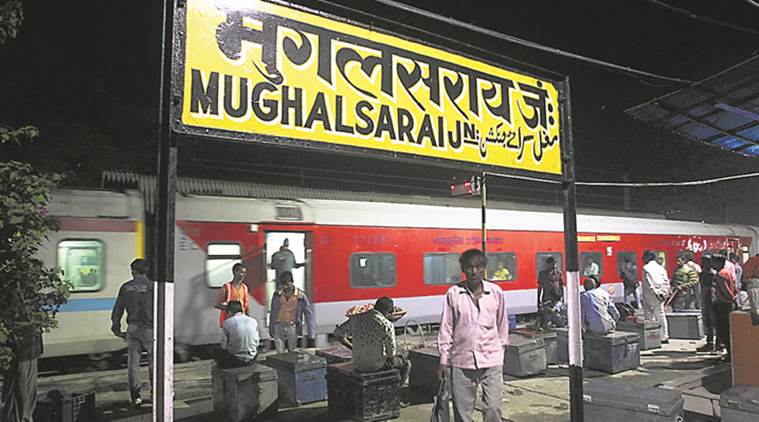" It was a landmark chapter in the evolution in the Indian Railways. Its name should not have been changed or rechristened after anybody," lamented noted historian Irfan Habib.
 Mughalsarai station in Uttar Pradesh was renamed after RSS ideologue Deen Dayal Upadhyaya
Mughalsarai station in Uttar Pradesh was renamed after RSS ideologue Deen Dayal Upadhyaya
The rechristening of the over 150-year-old Mughalsarai station in Uttar Pradesh has been red-flagged by historians and heritage experts, some of whom feel “erasing a landmark chapter” in the evolution of railways in the country will lead to “terrible confusion” among travellers.
The Uttar Pradesh government recently issued a notification saying the station, a major railway junction in northern India on the Delhi-Howrah line, has been renamed after RSS ideologue Deen Dayal Upadhyaya, with Governor Ram Naik giving his assent. This sparked a public outcry.
“History should be respected as it is. Mughalsarai was a historic railway station and part of childhood memories of millions of people. It was a landmark chapter in the evolution in the Indian Railways. Its name should not have been changed or rechristened after anybody,” lamented noted historian Irfan Habib.
He said he has fond memories of travelling in trains and looking forward to arrival of the station, where the familiar buzz of the tea-sellers and food vendors, would fill the air amid the background announcement of the train having arrived at ‘Mughalsarai’. “Somehow, the place, will now feel unfamiliar. I will miss it… I feel a part of my childhood memories has been robbed,” he told PTI. The historian alleged that for powers that may be, first the British names were a problem, and now anything that has a “Mughal or Islamic identity attached to it” from roads to parks.
Kolkata-based photographer and railway enthusiast Rajiv Soni, 65, recalled the Delhi Express that he used to catch from Calcutta that went via Mughalsarai and the “ceramic-made bowl-within-a-bowl” that he used to haggle for at the platform when the train halted. “All major trains, go via Mughalsarai. The trains were timed so precisely that one would reach for breakfast in Patna, lunch in Mughalsarai and tea in Kanpur. The renaming will now kill all those romantic memories and nostalgia. The renaming was totally unwarranted as Mughalsarai was a very innocuous name with no religious identity,” he rued. It was a landmark, transit point, and reference point for going to Benares or Mirzapur. The renaming doesn’t make any sense, Soni said.
Mughalsarai station was created as part of the Delhi-Howrah line laid in the 1860s and is one of the busiest railway stations of India with a large number of passenger and freight trains passing daily through it both ways. Its marshalling yard is also the longest in Asia. Initially part of the East Indian Railway (EIR) company, it is now part of the East Central Zone (ECR) zone of the Indian railways.
Architect and industrial heritage expert Moulshri Joshi slammed the renaming of the station, which she said, represented the “technological achievement” in the transport sector that that “we are proud of”. “It was built in the 1860s, when railways was still evolving and it has this beautiful long platform vault and one side has an ornate wrought-iron work too on the iron pillars. It is so much part of the public memory, more than transport heritage, a part of the cultural ethos,” she said.
“This rechristening has nothing but a political agenda, and the renaming amounts to erasing public memory associated with places, landmarks no less. It will also be loss of a railway heritage, as the new name will disguise so much of history, not to mention spawn confusion among people for a long period of time,” Joshi said. The architect, who has worked on projects to document industrial heritage of the country, asked, whether “deliberations and consultations” were done with experts and the public at large before taking such a “sweeping decision”.
Retired senior railway officer and former member of the Railway Board, Subodh Jain, said, Mughalsarai station is part of the iconic history of railways, and that name is a “very integral part” of it. “The junction has two lines emanating on both sides. Roughly 300 trains in total, passenger and freight ones, pass through in both ways. It has the largest marshalling yard in Asia, and therefore it is part of the railway heritage. And, heritage must be protected,” he said.
Vikas Dilawari, a Mumbai-based conservation architect, said the name may have been changed but its legacy will endure like the famous “VT station of Bombay”. “History should be left undisturbed and untampered. New buildings and new stations can be built to reflect memorialisation of a personality. Old places and names reflect the authentic intangible heritage of it,” he said.
Dilawari, however said, like the UNESCO World Heritage site Victoria Terminus (VT), Mughalsarai’s name too will linger on in public consciousness if not on paper. “Old-timers and locals and taxi drivers still call it VT, even though it was renamed twice, first to Chhatrapati Shivaji Terminus (CST) and then Chhatrapati Shivaji Maharaj Terminus (CSMT),” said Dilwari, who was part of the team that had prepared the dossier for VT’s UNESCO bid in 2003.
The Uttar Pradesh government had in June last year decided to rename Mughalsarai Junction in Chandauli district after Upadhyaya, who was found dead near the station in mysterious circumstances in 1968. Some people may argue, what’s in a name, “well there is a lot, when you have history and heritage riding on it,” said architect Joshi.




.jpg)
.jpg)



0 comments:
Post a Comment